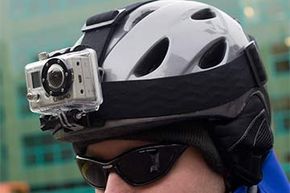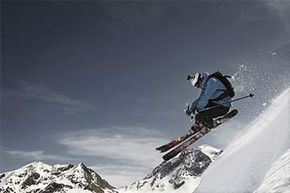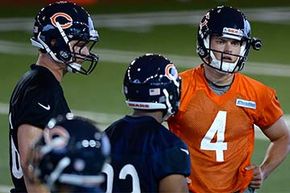Mountain biking, skydiving and police chases are all pretty cool things to witness firsthand, but my scaredy-cat self isn't likely to partake anytime soon. Helmet cameras are the perfect go-between for people like me, who enjoy watching other people's high-thrills footage without the risk, as well as for daredevils who want to re-live their outdoorsy experiences via high-definition images and video.
Today's helmet cams are compact, sleek, lightweight and usually waterproof, but like all great modern technology they started out much differently. In fact, helmet cam pioneer, mountain biker and video enthusiast Mark Schulze kicked off the practice in 1987 by bolting an old-school VHS camera to his bike helmet. For those of you who weren't around in the '80s, such cameras were big, bulky and likely headache-inducing when carried about on one's head. Those extra pounds were just the beginning, though, since wireless technology wasn't exactly available back then, either. Schulze actually placed a VCR, connected by cables to the camera, in his backpack and schlepped that around as well. His vision was to create instructional mountain biking videos, but at some point other companies caught onto his idea and used their considerable resources to design and produce helmet cameras with less bulk and higher quality [source: Mooney]. Today, helmet cameras are widely produced by manufacturers such as GoPro, Sony and iON, among others, and are often referred to as "action cameras."
Advertisement
Since then, people have dozens of uses for the camera beyond extreme sports. Helmet cameras have been used by football teams and firefighters as learning tools, or by police officers as insurance that their procedures were done by the book. Surfers and skiers get to capture beautiful footage of waves and mountains that would be impossible otherwise.
On the flip side, some people insist that helmet cams violate privacy rights, particularly in emergency situations. A township in Pennsylvania banned firefighters from using them. "I don't want somebody coming in my house and filming ... my wife might be in her negligee," was the town commissioner's memorable quote [source: Fire Rescue1]. Employers also point out that such video can increase liability, as illustrated by images of the aftermath of an Asiana Airlines crash in San Francisco, which depicted a survivor accidentally being run over by a fire rig. She was killed instantly [source: ARFF].
Despite the hesitations of some, many people are outfitting their helmets with these cool, lightweight video-making tools. Keep reading to find out who uses them, why and how you can too.
Advertisement


